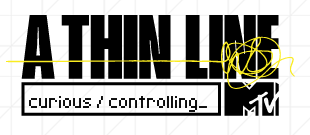When I looked at my wordpress dashboard this morning I noticed that I had 14 drafts–these are entries that I have started, but never completed. Right now I’m in the process of looking through these drafts so I can either delete them or (finally) post them. This entry started as a draft way back on March 7, 2010.
 As seen on a commercial/PSA for MTV: There is a thin line between curious and controlling. This reminds me of the chapters I read about staring from Rosemarie Garland Thomson and her book, Staring:How We Look (I assigned it for my troublemaking grad class in March 2010). Curiosity has been used to excuse a lot of behavior and also stems from a quest for knowledge; we use the desire to know as a way to scrutinize, to pick apart, to dissect, and to conquer. How do we navigate this danger of curiosity?
As seen on a commercial/PSA for MTV: There is a thin line between curious and controlling. This reminds me of the chapters I read about staring from Rosemarie Garland Thomson and her book, Staring:How We Look (I assigned it for my troublemaking grad class in March 2010). Curiosity has been used to excuse a lot of behavior and also stems from a quest for knowledge; we use the desire to know as a way to scrutinize, to pick apart, to dissect, and to conquer. How do we navigate this danger of curiosity?
In preparing to post this brief entry, I decided to do a little more research on the MTV PSA. I found out that it is part of “A Thin Line” campaign against digital abuse (sexting, textual harassment, cyberbullying) for youth. Here’s a blurb on their about us page:
MTV’s A Thin Line campaign was developed to empower you to identify, respond to, and stop the spread of digital abuse in your life and amongst your peers. The campaign is built on the understanding that there’s a “thin line” between what may begin as a harmless joke and something that could end up having a serious impact on you or someone else. We know no generation has ever had to deal with this, so we want to partner with you to help figure it out. On-air, online and on your cell, we hope to spark a conversation and deliver information that helps you draw your own digital line.
I’m fascinated (not uncritically so) by this site and their project. I will definitely have to check it out more when I have time. I might even want to get my students in my feminist debates class to critically analyze it–especially in terms of the number of different ways the site encourages the user to not just read about the problem but to do something (post a story, do an action, spread the word, draw a line, etc). We could also analyze it in relation to family values and youth. For my spring 2010 feminist debates class we discussed youth, values and cyberbullying. I am also fascinated by their emphasis on the “line”: the line between curious and controlling, virtual and real, love and abuse, use and abuse, etc and drawing a line (as in, taking a stand) against the problem of digital abuse. What is the site/campaign doing with (and to) these binaries? Busting them? Reinforcing them? How do we think about the “line” as one that is both thin and as that which must be drawn?
In looking for a link to Garland-Thomson’s book on staring, I found a great video in which she describes her project:
